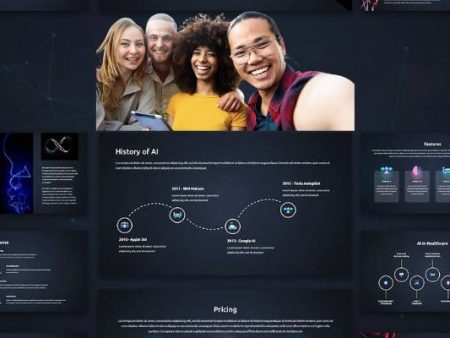You’ve probably been there. A big presentation looms—maybe it’s a quarterly review, a pitch to investors, or a strategy session.
You have the data, the ideas, and the urgency. What you don’t have is time. Or, frankly, the design chops to make your slides look like they belong in a Fortune 100 deck.
That’s when the question sneaks in: do I call a designer, or do I let AI do the heavy lifting? The rise of how ai presentation tools has made this decision more pressing than ever.
Canva, Beautiful.ai, Tome, Microsoft Copilot—they all promise slick, professional slides in minutes. But can these platforms truly replace the human artistry of a designer?
Why Corporate Presentations Matter More Than Ever
Corporate presentations aren’t just slides—they’re reputations on display. According to research from Venngage, 84% of professionals say that visuals are critical in persuading an audience during business communications. It’s not just about looking polished; it’s about trust, clarity, and impact.
In the high-stakes environment of corporate boardrooms, design isn’t decoration. It’s persuasion. That’s what makes this debate so charged. If AI can match or surpass designers in this domain, the implications go far beyond convenience.
How AI Presentation Tools Are Changing the Game
Let’s take a closer look at how ai presentation tools actually function. At their core, they use machine learning models trained on millions of slide templates, design patterns, and visual frameworks.
Input your prompt—say, “10-slide pitch deck for a fintech startup targeting millennials”—and out comes a polished draft.
Some platforms go further. Tome, for example, emphasizes storytelling structure. Microsoft Copilot can pull directly from Word docs, Excel sheets, and even meeting transcripts to generate content. Canva’s Magic Design lets you drag in data and instantly formats it into clean visuals.
This isn’t just automation—it’s design democratization. Tools once locked behind Adobe’s complexity or pricey design teams are now accessible to interns and CEOs alike.
The Creative Edge: Can Machines Mimic Human Nuance?
Here’s where it gets tricky. Graphic designers don’t just place text in boxes. They understand cultural nuance, tone, and audience psychology. They sense when a slide feels “too corporate” or “too playful.”
AI tools? They optimize for patterns, not feelings. That’s why some decks, while visually sharp, can feel generic. A designer would catch the subtle mismatch between your brand’s edgy voice and a pastel template. An algorithm? Not so much.
So while AI excels at producing clean, quick drafts, it struggles with nuance—the “soul” of design, if you will.
Why Gen Z Professionals Embrace AI Faster
One fascinating dynamic in this conversation is generational. Studies show that why gen z professionals are adopting AI design tools at a much faster rate than their older counterparts.
Why? A few reasons:
- They grew up in a digital-first world where automation feels natural.
- They value efficiency and experimentation over tradition.
- They’re often working in startups or flexible roles where budgets don’t allow for full-time designers.
For Gen Z, AI isn’t a threat to creativity—it’s a collaborator. Their comfort with blending tech and human input might just shape the norms of corporate design moving forward.
The Hybrid Model: Where Designers and AI Meet
Instead of asking whether AI will replace designers, maybe the better question is: how will the two work together?
Here’s how I see it:
- AI handles the grunt work: formatting, resizing, data visualization basics.
- Designers elevate the deck: injecting originality, refining tone, aligning with brand identity.
Think of it like accountants with Excel. Spreadsheets didn’t kill accounting—it made accountants more strategic. The same may hold true here.
AI for Academic Presentations: Lessons for Business
Interestingly, the rise of ai for academic presentations: offers a glimpse into how corporate adoption might evolve.
In universities, students are turning to AI to generate class decks in minutes. Professors are divided: some see it as a loss of critical thinking, others as a way to level the playing field.
In both classrooms and boardrooms, the pattern is clear: AI gives users a head start, but human editing is where the real learning—and real persuasion—happens.
Can AI Replace Graphic Designers?
So let’s tackle the central question head-on: can AI replace graphic designers in corporate presentations?
My take: not fully. AI can absolutely replace the functional role of designers for simple decks. If all you need is “clean, professional, on-brand,” AI has you covered.
But when the stakes are higher—when millions are on the line in the future of investor pitches, or when you need to convey complex ideas with emotional depth—designers still hold the edge.
AI gets you to “good enough.” Designers take you to “unforgettable.”
The Risks of Over-Reliance
That said, there are risks in leaning too heavily on AI:
- Homogenization: Decks risk all looking the same if everyone uses the same platforms.
- Skill Loss: Employees may lose the ability to craft presentations from scratch.
- Ethical Concerns: Overusing AI raises questions about originality and intellectual property.
These aren’t deal-breakers, but they are reminders that human oversight matters.
Case Studies: When AI Shines, When Humans Win
- AI Victory: A mid-sized marketing firm used Beautiful.ai to create hundreds of campaign recap decks. Clients were satisfied, costs dropped, and turnaround time halved.
- Human Victory: A startup pitching to VCs ditched AI-generated slides after test runs felt flat. They hired a designer who built a deck with bold metaphors and custom visuals. The result? Funding secured.
Both cases illustrate the nuance: AI is powerful, but not a universal replacement.
The Future of Investor Pitches
Looking forward, the future of investor presentations may be where this debate intensifies most. Investors are inundated with decks.
An AI-polished presentation might get you through the door, but to stand out, you’ll need creative storytelling, design flourishes, and emotional resonance that machines haven’t mastered yet.
Imagine an AI drafting the numbers, charts, and structure while a designer refines the story arc and emotional punch. That hybrid might just define the future of pitching.
Conclusion: Augmentation, Not Replacement
So, can AI replace graphic designers in corporate presentations? The answer is no—with an asterisk.
For routine, low-stakes decks, AI is more than enough. For high-stakes presentations, human designers are still indispensable. The sweet spot lies in augmentation: letting AI handle the heavy lifting while humans bring creativity, empathy, and nuance.
In the end, the question isn’t whether AI will replace designers. It’s whether we’ll learn to use these tools wisely—saving time, boosting quality, and remembering that the real power of a presentation doesn’t come from the slides at all. It comes from the person standing in front of them.


